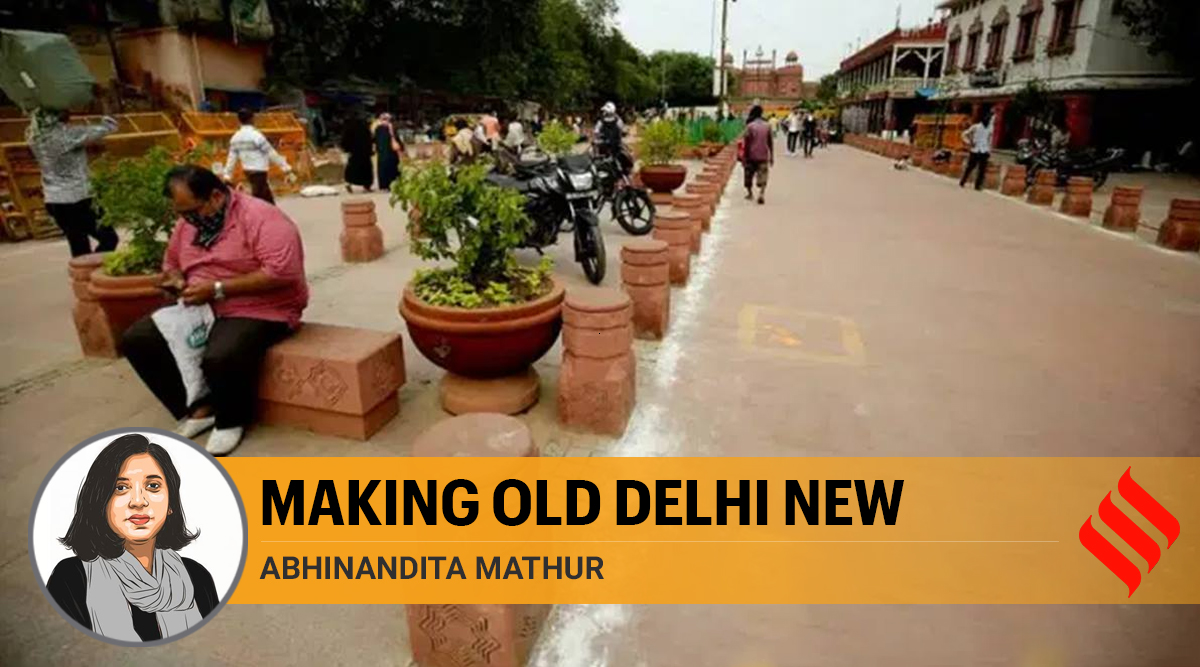 Beautification work underway at Chandani Chowk area in Old Delhi on Friday. (Express Photo by Praveen Khanna)
Beautification work underway at Chandani Chowk area in Old Delhi on Friday. (Express Photo by Praveen Khanna)
In 2005, the Majestic cinema on the main Chandni Chowk road was replaced by an outlet of McDonald’s, the first in Old Delhi. I remember a conversation with a relative, who is also from Old Delhi. I told her how heartbroken I and my “culturally sensitive” friends were. But Vandana bhabhi was ecstatic, “Chandni Chowk walon ki toh lottery nikal gayi, wahan Mcdonald’s khul gaya!”, she said. My nostalgia, I realised, was meaningless.
In the late 1980s, many families like mine sold their havelis and moved to East Delhi and other emerging suburbs because Chandni Chowk was no longer suitable for modern living. That change was hard but inevitable. A garden, clean terraces, attached bathrooms, parking area and other benefits of modern housing were essential for the growing families who could no longer fit in their havelis.
While some residents managed to move out, there were others who stayed back to maintain the dilapidated ancestral homes. Slowly, the residents who moved away stopped visiting. The raunak of Purani Dilli disappeared with the rihaish and made way for the ever-increasing chaos of commercial activity. Our homes turned into katras and our favourite grocery and mutton shop in Cheera Khaana lost all business. In no time they moved to Patparganj, following their loyal clientele.
The recent redevelopment work done by the AAP government under the Chandni Chowk Redevelopment Plan brings hope for the area that has long been neglected by previous governments. Over the decades, the lack of planning, intent, dialogue and imagination had led to the horrific chaos that is Old Delhi. The authorities failed in providing even basic amenities for the area. A version of the current plan was initiated in 2004 by the then Congress government, but it did not see the light of day.
Solving the complex problems of Shahjahanabad requires determination and dedication. The current Delhi government recognises the need for modernisation, is supportive of commercialisation and respectful of heritage. The arguments critical of further commercialisation of the area are based on an aesthetic consideration that is detached from the practical needs of the residents. Old Delhi’s makeover has to be placed in the future and not in the past. The real stakeholders of the area — residents, traders and those in the tourism business — are in the best position to contribute to the area’s redevelopment in collaboration with the government.
The key question is: What is a viable and sustainable model for the redevelopment of Shahjahanabad? The government has been working in consultation with local stakeholders, city planners and architects to expand the project. A number of issues like overhead wires, sanitation, traffic and illegal construction have emerged as a result of these dialogues. After the launch of the first phase by the chief minister last month, public representatives from the area were flooded with demands and ideas for improving amenities in their neighbourhood. The project will impact not just the main touristy areas, but even the narrow bylanes of Shahjahanabad.
Explained: What will the new Chandni Chowk look like?
Old Delhi cannot be merely preserved — it is living heritage and it needs to grow. A comprehensive policy must rely on tourism as a significant source of income for the local community, which will in turn help in valuing the heritage. The first phase of Chandni Chowk redevelopment has done just that. It has cracked a model that incentivises the locals to support the project.
The Delhi government plans to invest in cultural spaces and projects in the area. It will organise monthly cultural programmes, celebrating Delhi’s typical music, food and composite culture, along the lines of the Mehrauli Monsoon Festival and the Shahpur Jat Autumn Festival. These festivals attract local participation and manage to share the cultural heritage of the villages with a wider Delhi audience.
A balanced and comprehensive plan like this opens many possibilities and opportunities. The state government is determined to put Old Delhi on the map of World Heritage Cities as a successful model. This will, of course, come at the cost of romantic ideas of history, smells and textures of the dilapidating homes and rigid notions of heritage conservation. For the residents of Old Delhi, that’s no love lost.
This article first appeared in the print edition on August 14, 2020 under the title ‘Making old Delhi new’. The writer is an advisor to the Delhi government.